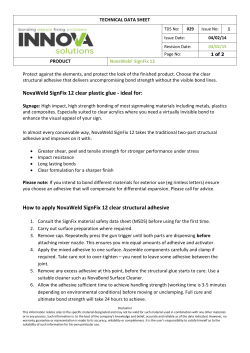
Converter Questions Answered THOUGHT
Thought Leadership Answers to frequently asked questions about pressure-sensitive adhesives There are many factors that brands and label converters need to consider when choosing a pressure-sensitive adhesive (PSA) for their product application, from cost to sustainability to performance to design. With these considerations come plenty of questions. For example, are some label adhesives more ecofriendly than others? Does the thickness of an adhesive matter? Here are the answers to some of the most common questions about PSAs. How do pressure-sensitive adhesives work? PSAs are adhesives that that will bond to a substrate surface with little or no energy. Unlike solvents and hot melt adhesives, which use chemical or mechanical processes to achieve adhesion, firm pressure is all that’s needed to create a cohesive bond between the PSA and substrate. This makes them ideal for labels, tapes and graphic signage. What are the different types of PSAs? Adhesives fall into one of three families: • Repositionable: An adhesive that adheres immediately, but if a label is misapplied, it can be removed cleanly from a container within a window of time, allowing a new label to be applied. Traits: Low adhesion • Removable: An adhesive that can be easily removed without damage to the label or substrate. Traits: Low to moderate adhesion • Permanent: An adhesive that is hard to remove and will cause destruction of the label or substrate when removal is attempted Traits: High adhesion Based on the product application, brand owners may need an adhesive that falls into more than one category, such as a removable, repositionable adhesive. Inspired Brands. Intelligent World.™ label.averydennison.com Thought Leadership Can one adhesive work with any application? Unfortunately, no. There’s a reason there are more than 300 different PSAs in the adhesives industry. Specific applications require label developers to create PSAs with specific performance properties, which can be achieved using several basic components. What components are used to make an adhesive? All PSAs are built on either a rubber or acrylic base, combined with a specific adhesive technology. There are four basic types of adhesive technology: emulsions, solvents, hot melts and UVhot melts. By putting these components together in different combinations, label developers can customize an adhesive to deliver the right mix of durability, flexibility, thickness, adhesion and other performance traits when the adhesive is applied to a liner and facestock. Examples include a removable acrylic emulsion PSA or a permanent rubber-based solvent PSA. How do I choose an adhesive for my product application? Selecting the proper adhesive is essential to the success of the label in each application. Understanding the environment and use of the label will help label developers and converters identify the correct adhesive for the application. Some factors to consider include: • Facestock: What type of facestock is being used? • Adhesive: What type of adhesive is needed (permanent, repositionable, etc.)? • Substrate: What will the adhesive need to stick to? • Application conditions: In what conditions will the label be applied? Why does the product container (substrate) affect which adhesive can be used on it? Adhesion strength of a PSA is dependent on several factors. First is the surface energy, or the amount of molecular force in the surface material it is applied to. High-surface-energy materials tend to be smooth and clean, and include metals, painted surfaces, dry glass and certain plastics, such as HDPE, PET and polypropylene. Waxy, soft and oily materials such as Teflon, rubber and silicone have a low surface energy. Most PSAs bond best when they can “wet out,” or spread on a surface. But low-surface-energy materials reduce the adhesive’s wetout ability. So converters must use a more aggressive adhesive, such as a solvent or hot melt, to bond to a low-surface-energy substrate, whereas an emulsion, or water-based adhesive, will work better with high-energy substrates. Does the shape and texture of my container matter? The shape and texture of a product container affects what PSA properties are needed to achieve good adhesion. A container that is bumpy or porous might require one set of adhesive properties, just as a smoother, larger container may require another set. In either case, adhesives can be adapted to maximize adhesion to the product’s surface area and texture. Are PSAs environmentally friendly? Although PSAs aren’t recyclable themselves, different adhesives offer different sustainable benefits for the end user. For example, many emulsion PSAs enable labels to be easily removed during recycling, which helps packaging reclaimers yield more recycled material for remanufacturing. Solvents, on the other hand, are harder to remove but require less energy than a hot melt, and less water than an emulsion. UV-hot melts and standard hot melts also eliminate the need for a label liner, reducing liner waste. > • Exposure conditions: In what conditions will the label be used? © 2013 Avery Dennison Corporation. Avery Dennison brands, product names and codes are trademarks of the Avery Dennison Corporation. All other brands and product names are trademarks of their respective owners. Asia Pacific 32/F., Skyline Tower 39 Wang Kwong Road Kowloon Bay, Kowloon, Hong Kong +852 2802-9618 Europe Lammenschansweg 140 2321 JX Leiden The Netherlands +31 71/579-4100 Latin America Rodovia VinhedoViracopos, KM 77 CEP 13280-000 Vinhedo - SP, Brazil +55 19 3876-7600 North America 8080 Norton Parkway Mentor, OH 44060 440.534.6000
© Copyright 2025









